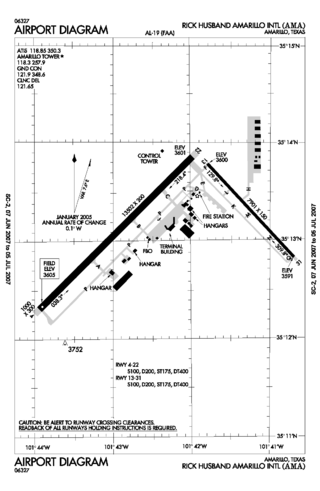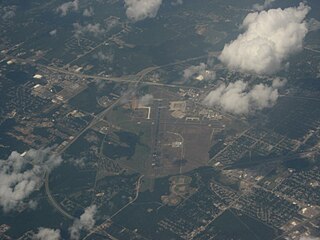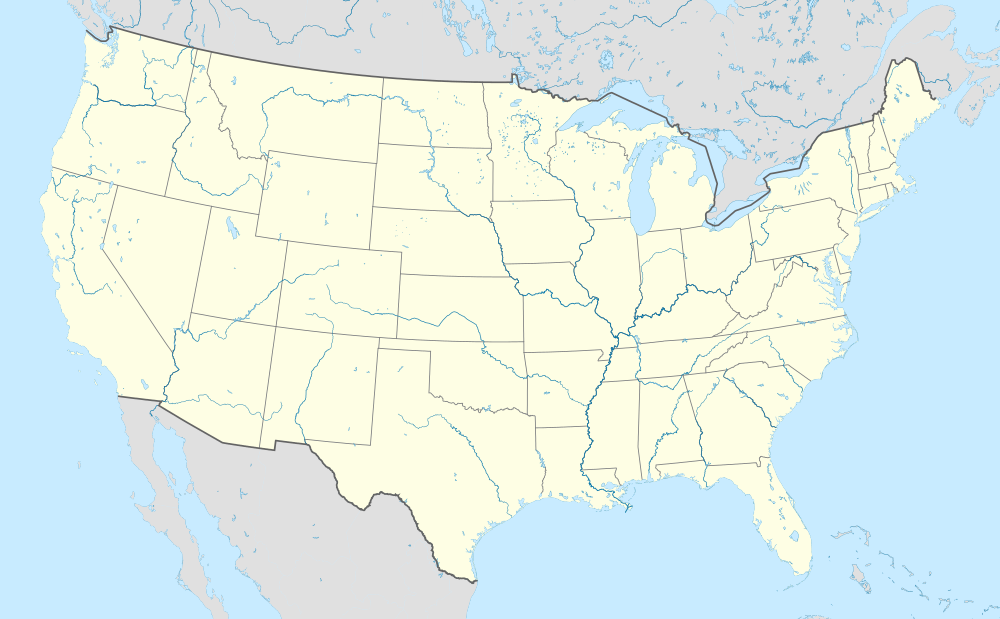
William P. Hobby Airport is an international airport in Houston, Texas, located 7 miles (11 km) from downtown Houston. Hobby is Houston's oldest commercial airport, and was its primary airport until the Houston Intercontinental Airport, now known as the George Bush Intercontinental Airport, opened in 1969. Hobby was initially closed after the opening of Houston Intercontinental; however, it was re-opened after several years, and became a secondary airport for domestic airline service, and a center for corporate and private aviation.

Eugene Airport, also known as Mahlon Sweet Field, is a public airport 7 miles (11 km) northwest of Eugene, in Lane County, Oregon, United States. Owned and operated by the City of Eugene, it is the fifth-largest airport in the Pacific Northwest.

St. Pete–Clearwater International Airport is a public/military airport in Pinellas County, Florida, United States, serving the Tampa Bay Area. It is right on the northeast municipal boundary of Pinellas Park, 9 miles (14 km) north of downtown St. Petersburg, 7 miles (11 km) southeast of Clearwater, and 17 miles (27 km) southwest of Tampa.
Panama City–Bay County International Airport(IATA: PFN, ICAO: KPFN, FAA LID: PFN) was a public airport 3 miles (4.8 km) northwest of Panama City, in Bay County, Florida. It was owned and operated by the Panama City–Bay County Airport and Industrial District. All airline services moved to the Northwest Florida Beaches International Airport on May 22, 2010, but the airfield was open to general aviation aircraft until October 1, 2010. The grounds will eventually be turned over to LUK-MB1 LLC, which plans to remove the runways and build homes, shops, walking trails and a marina.

Rick Husband Amarillo International Airport is a public airport six miles (10 km) east of downtown Amarillo, in Potter County, Texas, United States. The airport was renamed in 2003 after NASA astronaut and Amarillo native Rick Husband, who died in the Space Shuttle Columbia disaster in February of that year.

Corpus Christi International Airport is 6 miles west of Corpus Christi, in Nueces County, Texas. It opened in 1960, replacing Cliff Maus airport at 27.767°N 97.44°W, where the Lozano Golf Center is now located.

McAllen International Airport is in McAllen, in Hidalgo County, Texas, United States.

Lubbock Preston Smith International Airport is five miles north of Lubbock, in Lubbock County, Texas, United States. Originally Lubbock International Airport, it was renamed in 2004 for former Texas governor Preston E. Smith, an alumnus of Texas Tech University.
Jack Brooks Regional Airport, formerly Southeast Texas Regional Airport, is near Port Arthur, Texas, nine miles (14 km) southeast of Beaumont and northeast of Port Arthur. It was Jefferson County Airport, but its name was changed to honor former U.S. Representative Jack Brooks. The airport is southwest of the city of Nederland in unincorporated Jefferson County, and is used for general aviation. Southwest Airlines ended scheduled jet service in 1980 and several other airlines have started and ended service as well including American Eagle, Continental, Delta/Delta Connection and United Express. The latest chapter is the resumption of service by American Eagle for American Airlines to Dallas/Ft. Worth (DFW).

Monterey Regional Airport is three miles (5 km) southeast of Monterey, in Monterey County, California, United States. It was created in 1936 and was known as the Monterey Peninsula Airport until the board of directors renamed it on September 14, 2011.

Combi aircraft in commercial aviation are aircraft that can be used to carry either passengers as an airliner, or cargo as a freighter, and may have a partition in the aircraft cabin to allow both uses at the same time in a mixed passenger/freight combination. The name combi comes from the word combination. The concept originated in railroading with the combine car, a passenger car that contains a separate compartment for mail or baggage.

Idaho Falls Regional Airport is two miles north-northwest of downtown Idaho Falls, Idaho, United States. It is locally known as Fanning Field. It is the second-busiest airport in Idaho after Boise Airport.

Grand Junction Regional Airport is three miles (4.8 km) northeast of Grand Junction, in Mesa County, Colorado, United States. Owned by the Grand Junction Regional Airport Authority, it is the largest airport in western Colorado and third largest in the state, behind Denver International Airport and Colorado Springs Airport.

Shreveport Regional Airport is a public use airport in Shreveport, Louisiana, United States. It is owned by the City of Shreveport and located four nautical miles (7 km) southwest of its central business district.

San Angelo Regional Airport, serves San Angelo in Tom Green County, Texas, United States. The airport covers 1,517 acres (614 ha) and has three runways. It has free parking.

Abilene Regional Airport is a public airport located approximately 3 miles (4.8 km) southeast of downtown Abilene, in Taylor County, Texas. The airport is located within the Abilene city limits, and is and owned and operated by the city.

Brownsville/South Padre Island International Airport is 5 miles east of downtown Brownsville, Cameron County, Texas.

Providenciales International Airport, on the island of Providenciales in the Caicos Islands, is the main international airport serving the Turks and Caicos Islands, a British Overseas Territory of the United Kingdom. It is operated by Turks and Caicos Islands Airports Authority (TCIAA). The territory's other international airport is JAGS McCartney International Airport on Grand Turk Island. Currently, there are more than 12,000 commercial aircraft operations per year.

Piedmont Airlines was an airline in the United States that operated from 1948 to 1989, when it was acquired by and merged into USAir. Its headquarters were at One Piedmont Plaza in Winston-Salem, North Carolina, a building that is now part of Wake Forest University.

Robert Mueller Municipal Airport(IATA: AUS, ICAO: KAUS, FAA LID: AUS) was the first civilian airport built in Austin, Texas, United States. It was located a few miles northeast of downtown Austin. It was replaced as Greater Austin's main airport by the Austin–Bergstrom International Airport, which is located on the site of the former Bergstrom Air Force Base. The airport was named after Robert Mueller, a city commissioner who died in office in January 1927. Robert Mueller Municipal Airport was identified with the airport code AUS, which was reassigned to Austin–Bergstrom International Airport in 1999.






















